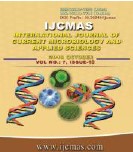


 National Academy of Agricultural Sciences (NAAS)
National Academy of Agricultural Sciences (NAAS)

|
PRINT ISSN : 2319-7692
Online ISSN : 2319-7706 Issues : 12 per year Publisher : Excellent Publishers Email : editorijcmas@gmail.com / submit@ijcmas.com Editor-in-chief: Dr.M.Prakash Index Copernicus ICV 2018: 95.39 NAAS RATING 2020: 5.38 |
Majority of the public ESP had buildings, furniture, transport facilities, computers, telephone facilities and very few had library, laboratory facilities demo farms and business enterprises, located at district head quarters and another half were located at mandal head quarters whereas private ESP had all infrastructure facilities and situated at district head quarters. Most of the NGO ESP had buildings and furniture facilities and situated at district and mandal head quarters. Public ESP covered entire district as well as entire mandals. Further, serving the farmers besides more than half of the public ESP had rural youth as their clients too and only few mentioned women were their clients. Private ESP provides their services in few selected districts, one district and in selected mandals, mainly focused on farmers in general. Whereas NGO ESP focuses on villages, entire mandal area and in few selected mandal areas and focused on farmers in general and majority of them were serving to women also. Half of the public extension service providers had daily visits where as the private ESP had every day visits to their clientele groups. Among the NGO ESP, majority were visiting daily. Majority of them recruit their staff directly as well as interview only. Majority of the public, private and NGO ESP had working experience in between 11 to15 years, 1 to 5 years and 6 to 10 years and number of villages covered in a week days by an individual were 30, 10 and 5 respectively. Half of the public ESP had GOI and another half of them had Government of Andhra Pradesh as their financing sources where as private ESP had generated their own funds. NGOs were having local donors followed international donors and FAO. All public and NGOs were controlling their staff through established procedures like issuing notices and memos where as private ESP followed transfers and reprimands later giving notices and memos. Majority of the respondents of all three ESP were expressed that they had free atmosphere for exchange of ideas with colleagues but not with the superiors.
 |
 |
 |
 |
 |